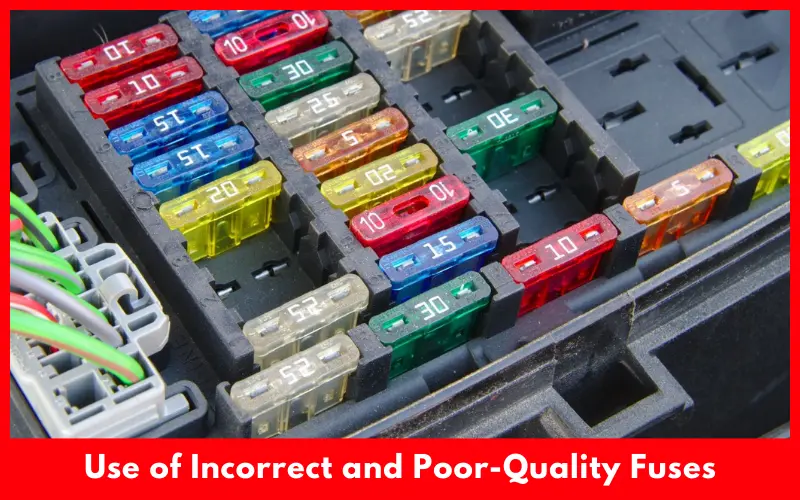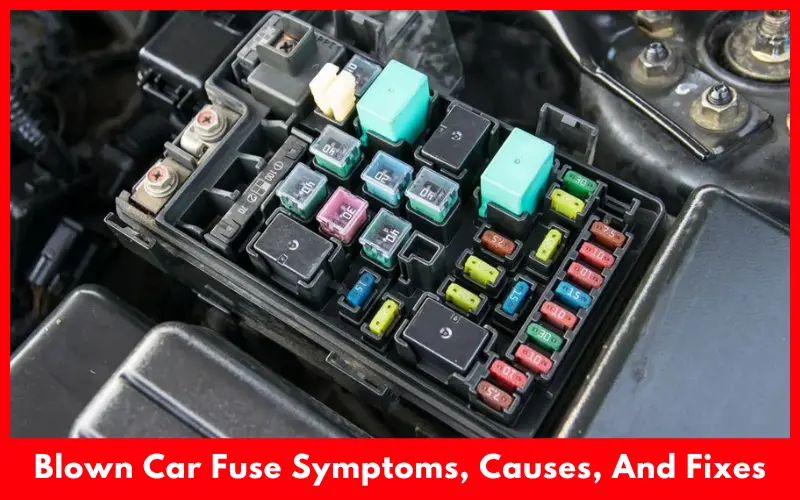Fuses are used in all types of modern cars. They are one of the most efficient components that keep car’s electronic devices safe. So a blown car fuse will effect most of your car electric parts.
Your car’s turn signal light won’t work properly, headlight may blink fast and power doors malfunctions due to a blown car fuse. We also have discussed major symptoms of a blown car fuse, causes and solutions.
As we know, there is a range of electronic equipment in your car, so the current flow to each part should be controlled, which is done through the help of fuses. Every vehicle from luxury European car to Japanese cars has a different number of fuses.
When an electronic component of your car, such as the air conditioner or headlights, stops working, it’s probably because your fuse has blown so you should visit European auto repair shop near you.
Article Summary
Symptoms of A Blown Car Fuse
Once the fuse of an electronic component in your car is blown, then it fails to function. Let’s discuss some common things that happen to your car if the fuse is blown:
- Power doors won’t working.
- Fan of your air conditioning system has stopped.
- Power outlets used to charge smartphones are not functional.
- SVC Sound system stops working.
- Headlights have stopped working.
Causes of Blown Fuses in Car
The fuse is designed to melt when a strong electrical current passes through it. If you put extra electrical stress on your car, the fuse melts to save other electrical components.

1. Electrical Overload
Electrical overload is a widespread and responsible cause of blown car fuses. It happens if the electrical circuit takes more current than what a fuse is designed to carry. It is essential for car owners and mechanics to comprehend the electrical overload dynamics.
Aftermarket modifications are not rare among car enthusiasts; they modify a vehicle by installing an aftermarket accessory, for example, sound systems or lights and other electronic devices. These additions might enhance the electrical load on the system more than fuses can carry.
You should ensure that such modifications are compatible with a vehicle’s electrical system and there is proper protection.
Electrical accessories that do not function properly, such as power windows, seat heaters, or air conditioners, can pull a high current, thus causing electrical overload. Monitoring and fixing problems with such elements can help avoid blown fuses.
2. Old And Faulty Components
Old or defective components in a car’s electrical circuit are one of the major causes of blown fuses. Knowing what role these elements play and how to tell when they are failing is important for proper maintenance that will help prevent electrical complications.
The electrical components in a car, such as the fuel pump and windshield wipers, are controlled by electromechanical relays.
Relays can also age and acquire internal faults, increasing relays’ resistance and increasing current draw. Inspection and timely replacement of worn-out relays can assist in preventing problems leading to burned-out fuses.
The ignition switch is an important part responsible for activating the electrical system upon turning the key. Intermittent issues in the system may be due to a faulty ignition switch, such as sudden loss of power.
While unattended, it may lead to blown fuses. Checking the ignition switch’s functioning regularly and replacing it if required may contribute to keeping a reliable electrical system. If your car’s fuses are blown frequently, there might be various underlying problems with the electrical system.
If you are new in town and don’t know where to get the issue inspected, then you can search for ‘car repair near me’ on maps with the highest positive reviews.
3. Use of Incorrect and Poor-Quality Fuses
Another often neglected aspect of vehicle maintenance is using substandard or wrong-type fuses, which can result in a blown car fuse. The use of appropriate type and grade fuses is key in preventing electrical problems.

Fuses are manufactured with particular amperage ratings that match the electrical circuits they shield. These ratings show the highest current levels that can pass through the fuse without burning it out.
A fuse rated at a higher amperage than recommended for a particular circuit can cause overcurrent and damage to the components.
In a car, the fuse limit is designed to work with each electrical circuit, from headlights to power windows. Information on the right fuse ratings for each circuit is often available in a vehicle’s manual.
An improper fuse amperage rating might seem a convenient repair, but it allows more current to pass through the circuit than its design specifications prescribe. This can lead to overheating, component damage, and even fire hazards.
4. Corrosion Due To Moisture Build-Up
Corrosion and moisture are forgotten when identifying the sources of electrical problems in autos that manifest as blown fuses.
Environmental factors, including corrosion and moisture, can substantially impact electrical components, especially regarding fuse failures; thus, understanding how these environmental effects contribute to the faulty functioning of a device is necessary for proper maintenance.
In other words, corrosion occurs when metals are attacked by moisture and oxygen with time. Exposed metal parts, including connectors, terminals, and fuse boxes, are subject to vehicle corrosion. The process of de-icing using road salt increases corrosion, particularly in cold winters.
Corrosion increases electrical resistance, thus impeding current flow. This resistance enhancement could result in the production of heat, voltage drops, and, finally, blown fuses. Corrosion also threatens the integrity of connections, affecting the functioning of electrical components.
Vehicles can be penetrated by moisture at different entry points, such as damaged seals or housing and improperly sealed connectors. Moisture accesses the engine compartment, interior cabin, and even fuse box, resulting in electrical issues.
Moisture is a conductor in which the current goes where there should be none. This leads to short circuits, increased current draw, and corrosion of metal components. With contaminants, moisture may provide an opportunity for electrical issues.
How To Fix A Blown Car Fuse?
Most modern cars come with two fuse boxes. You can find the first fuse box inside the engine bay; the fuses inside this box are used to protect the electrical components inside the engine, including the cooling and heating system, the engine control unit, ignition, brake pump, and a range of other components.
Meanwhile, the second fuse box helps protect the electrical components of the interior.
There is no option other than replacing a car fuse once it’s blown. You must replace blown car fuse by following the car owners manual recommendation. You can find amps reading on the box covering the fuse box.

